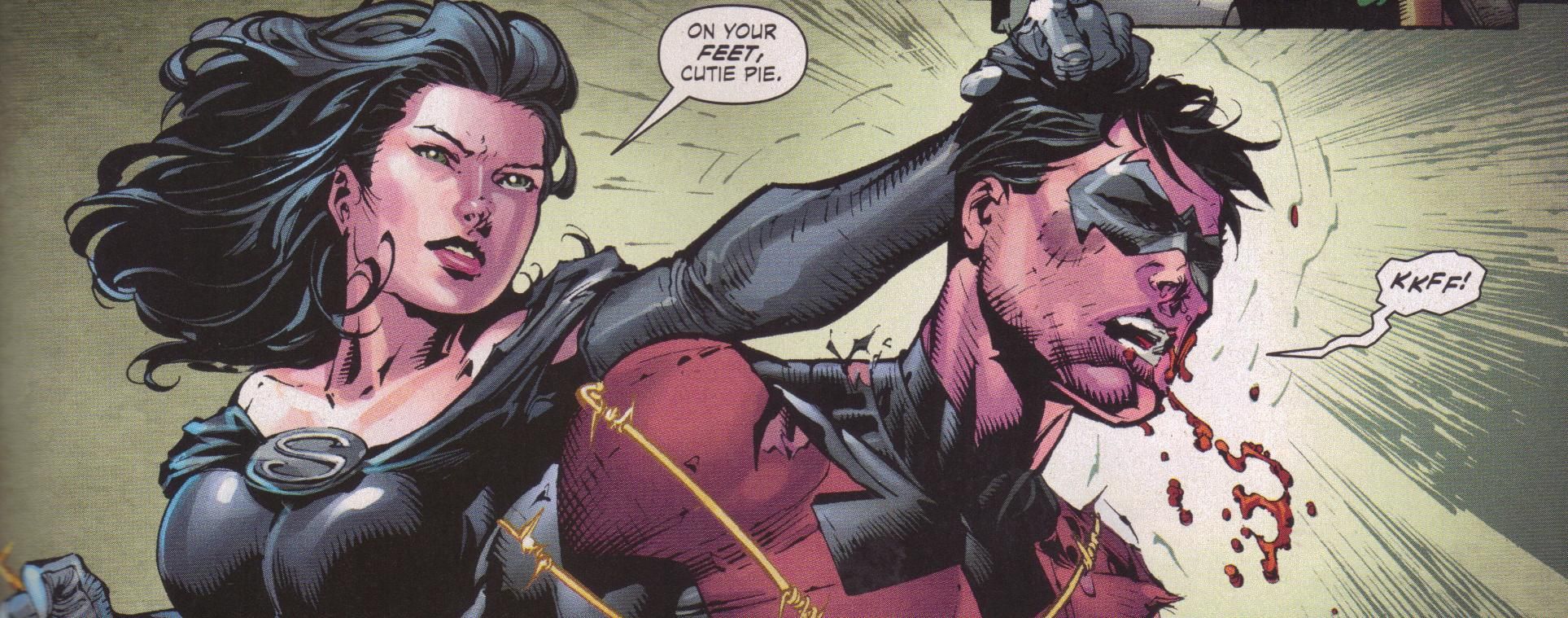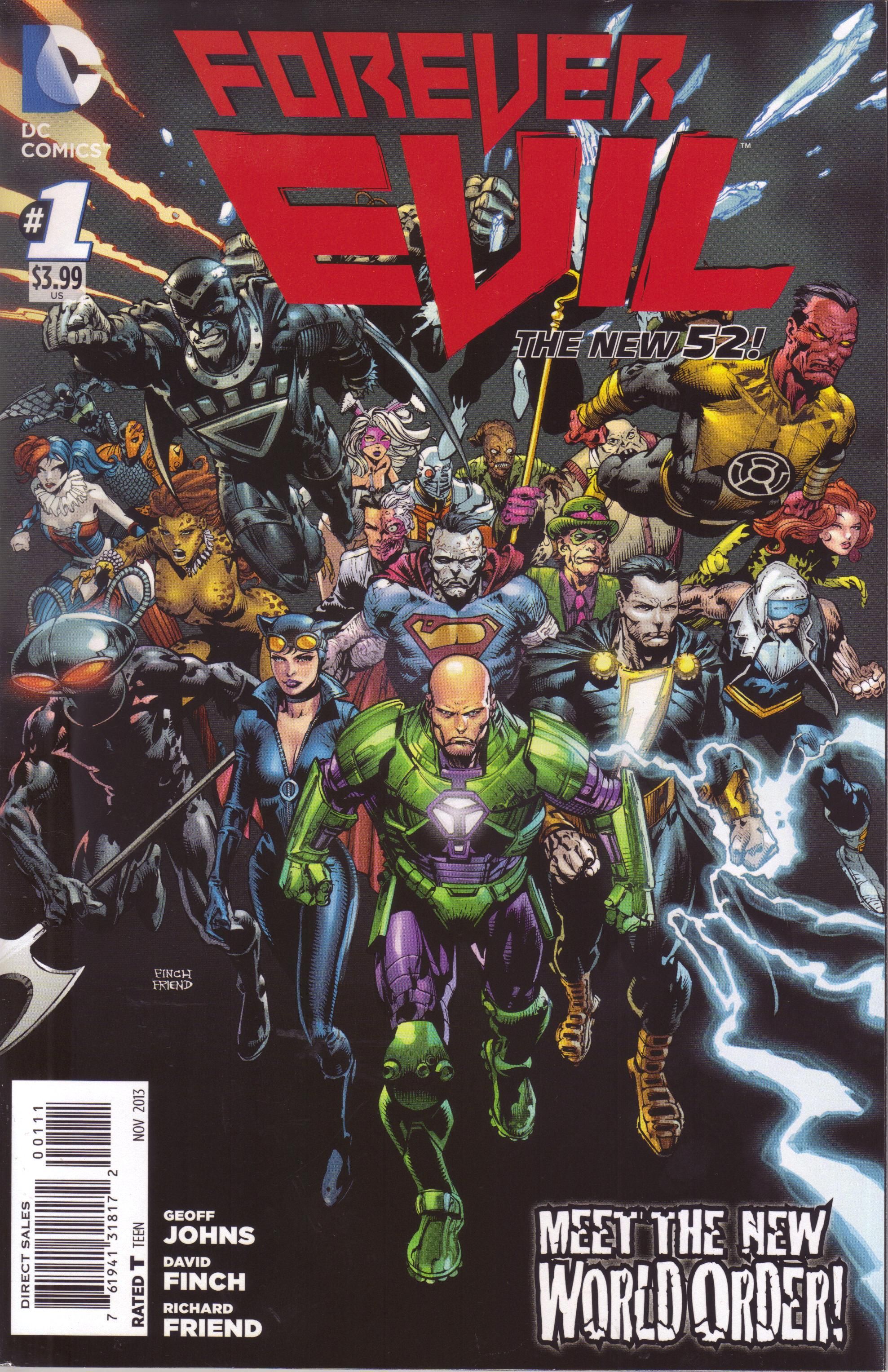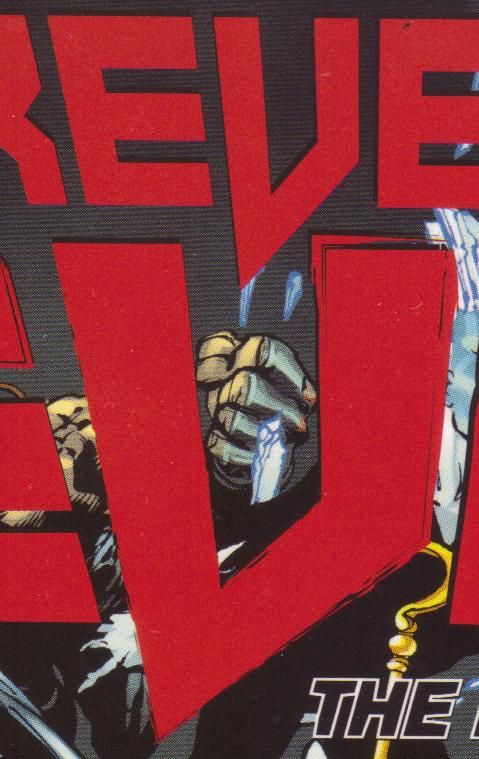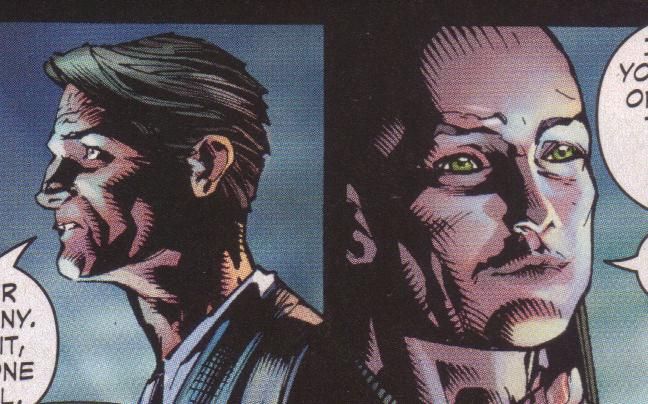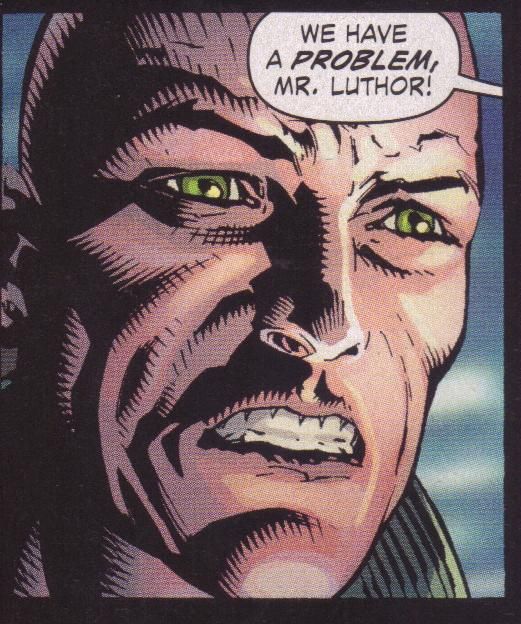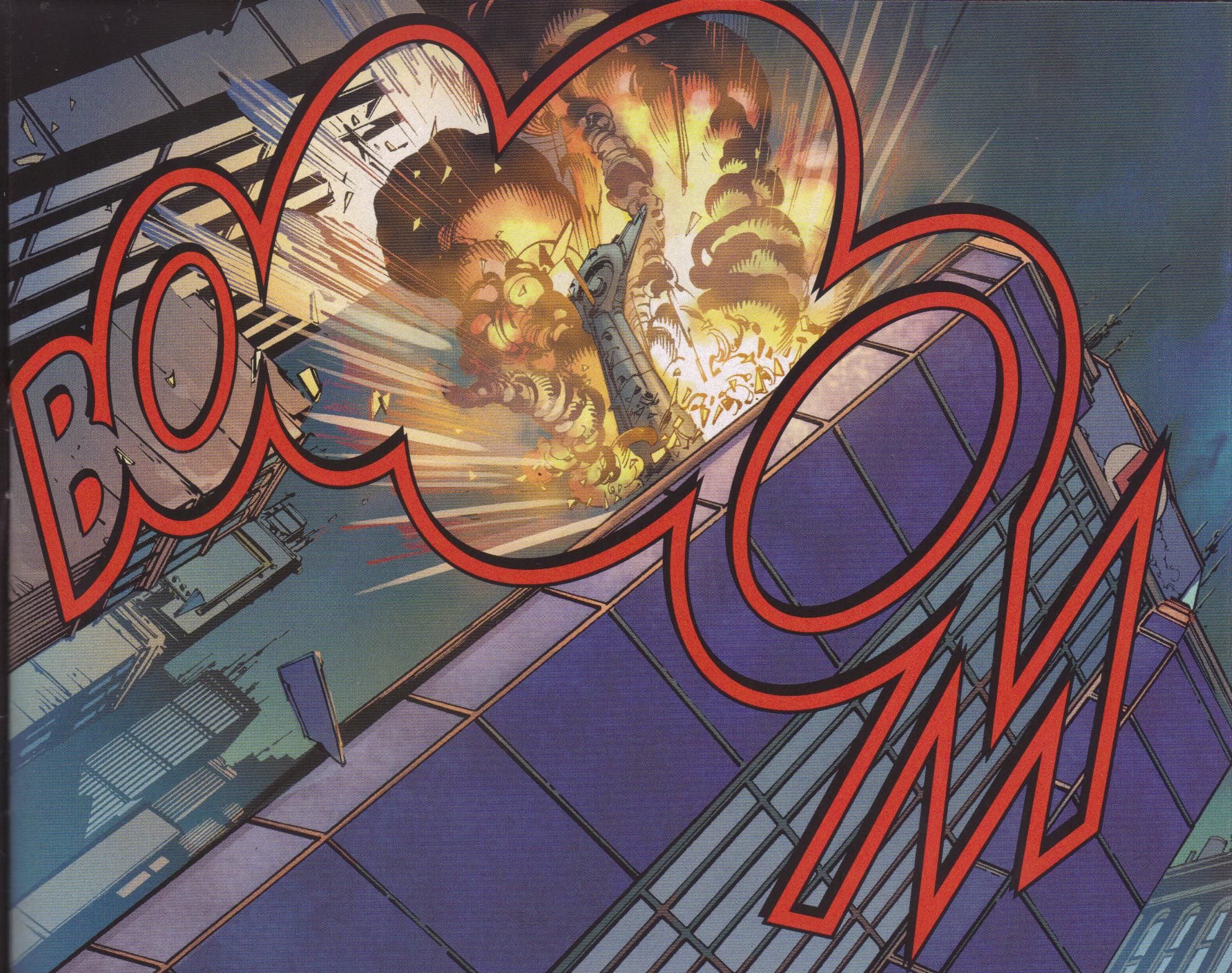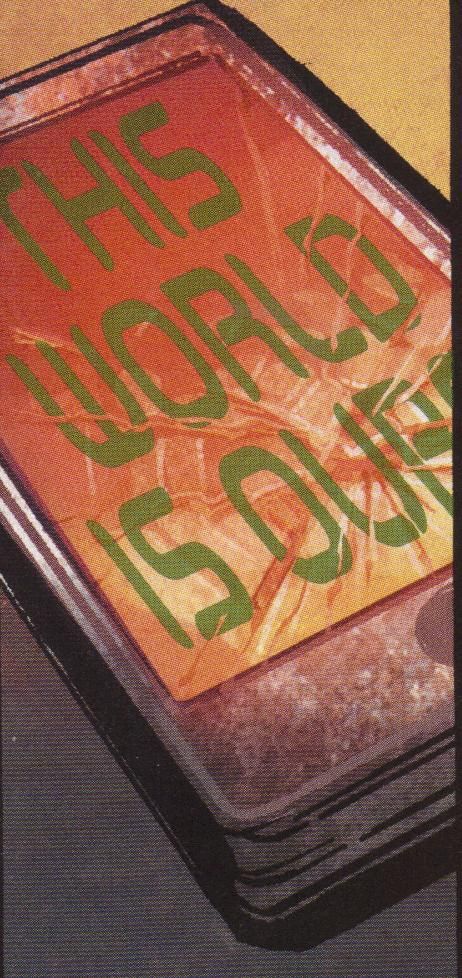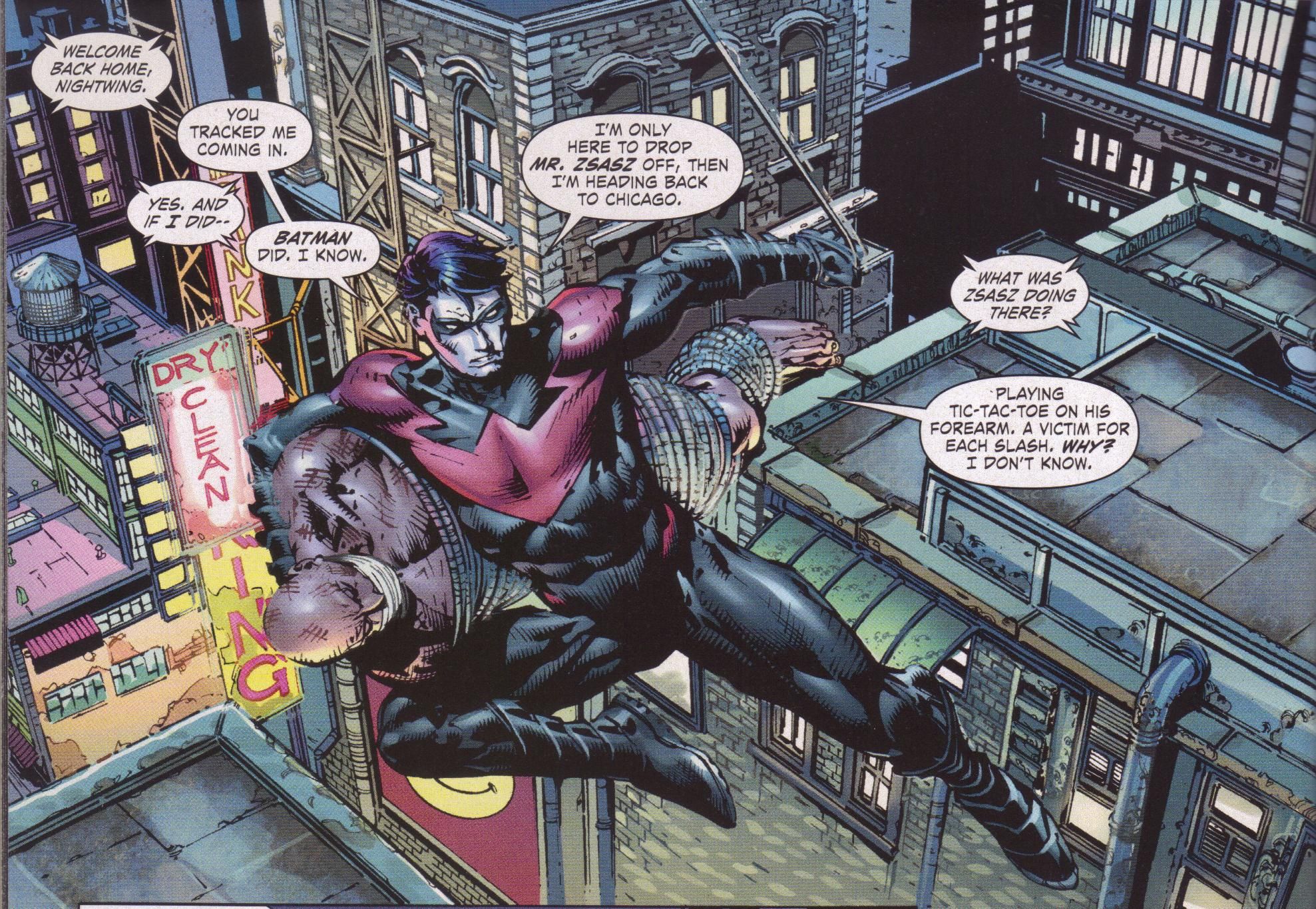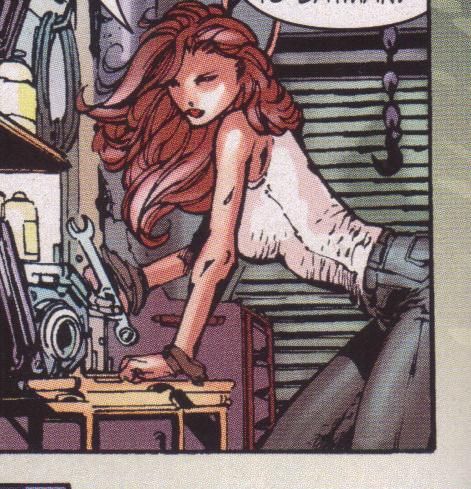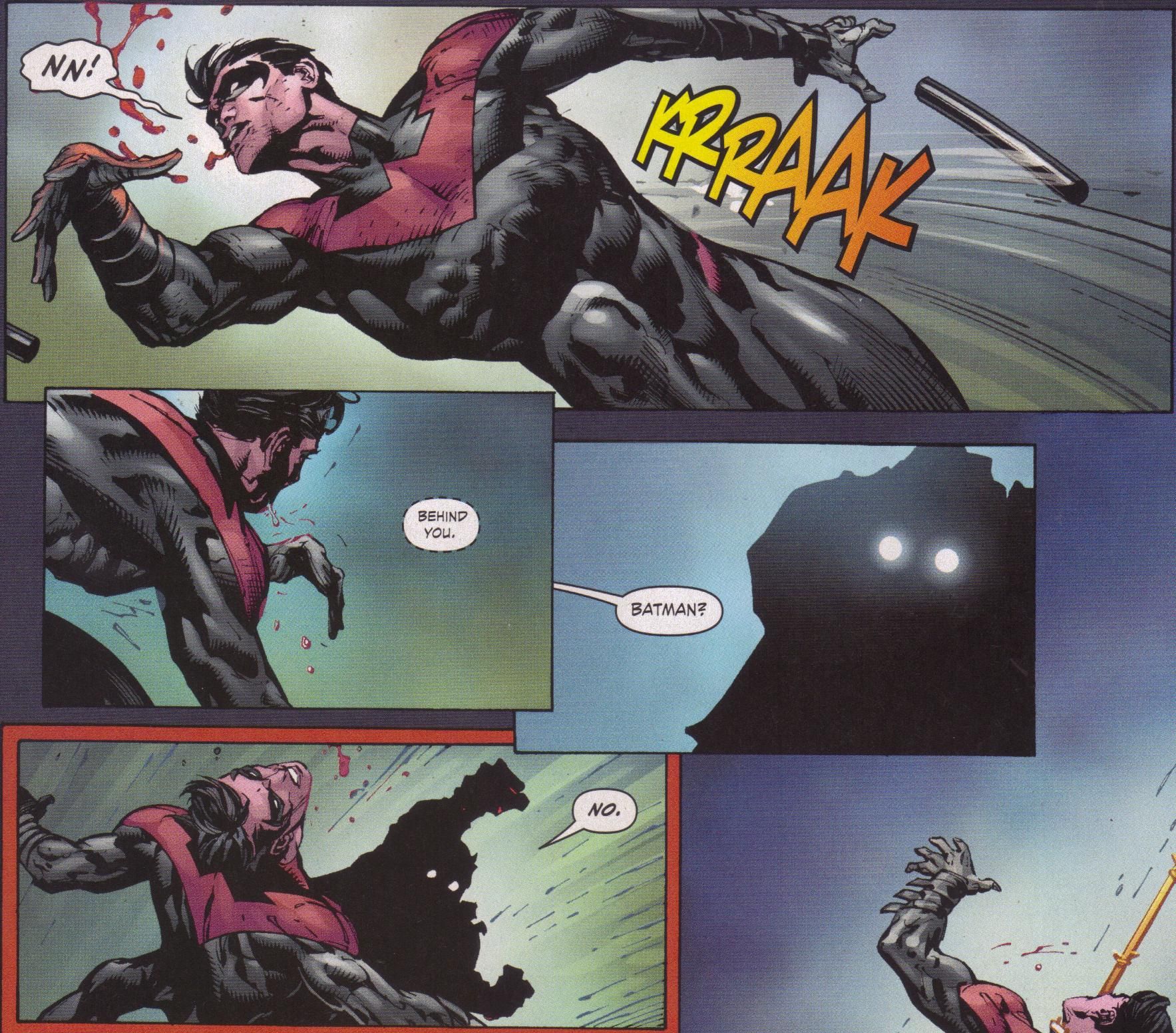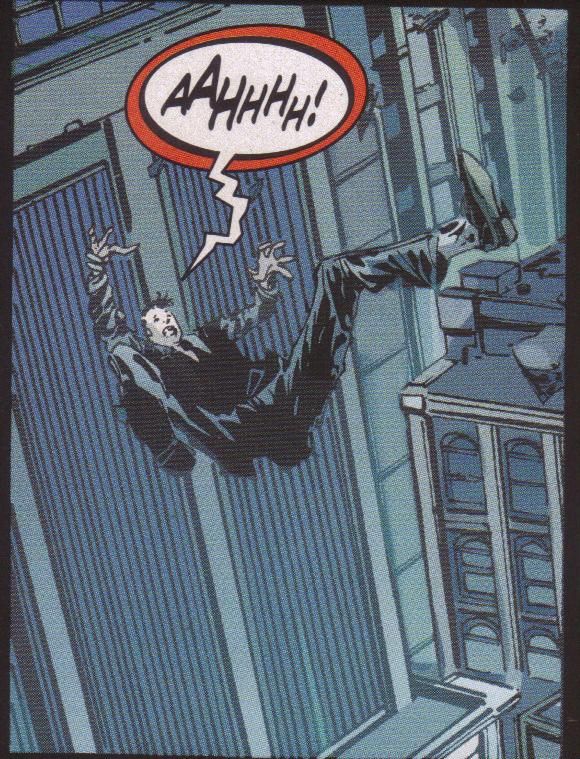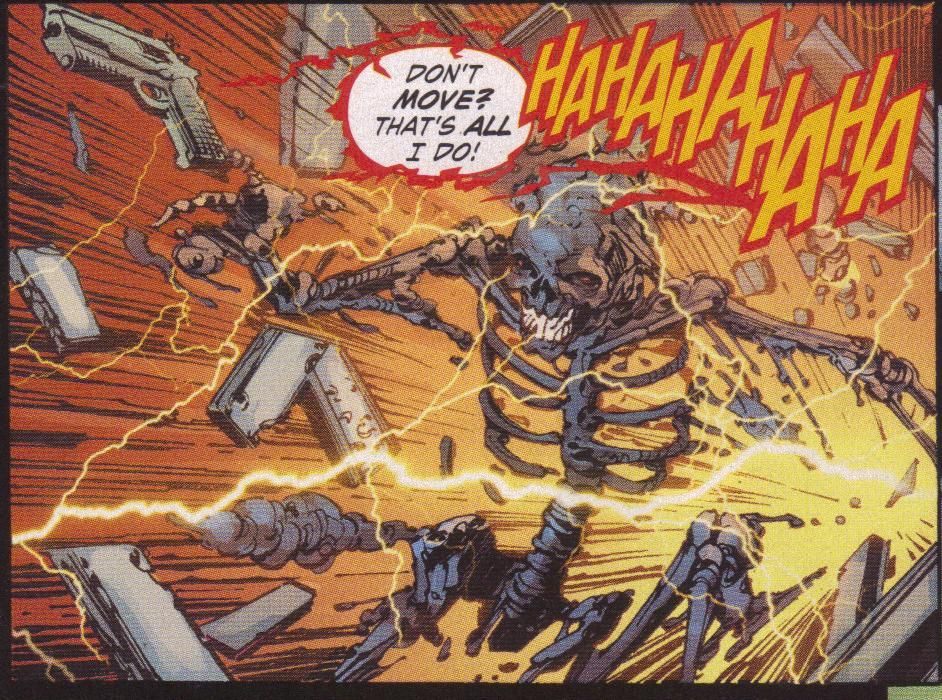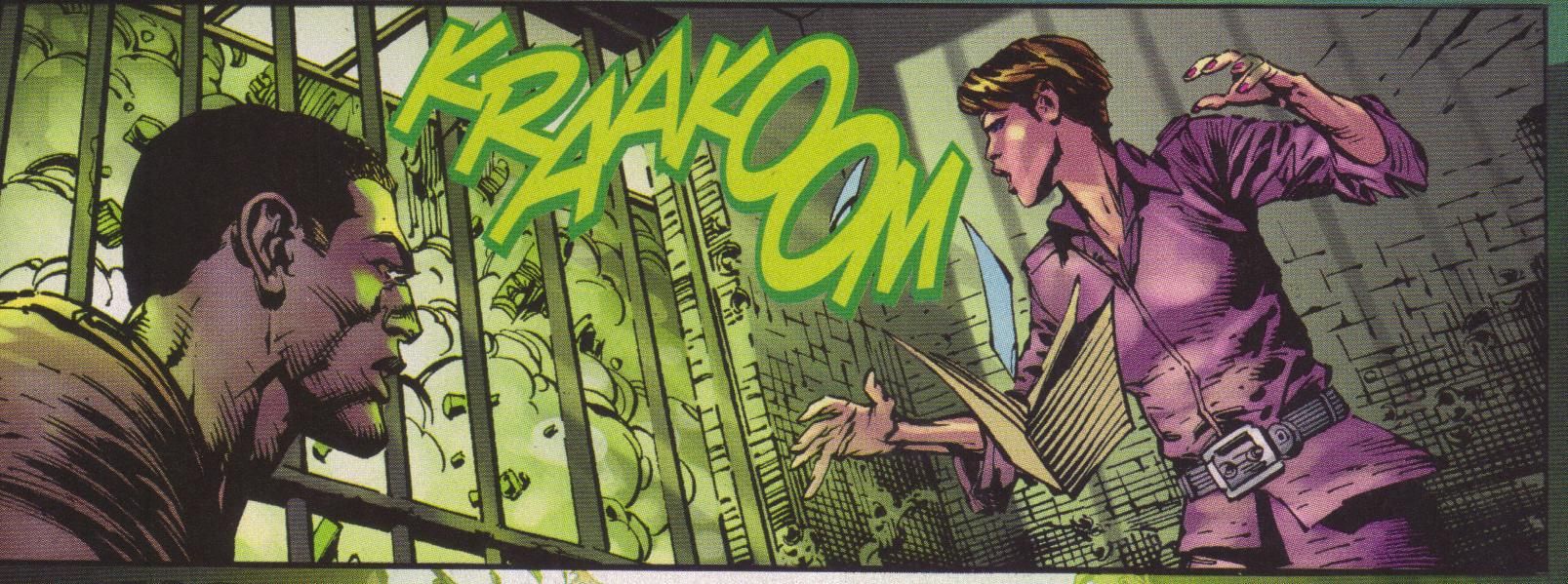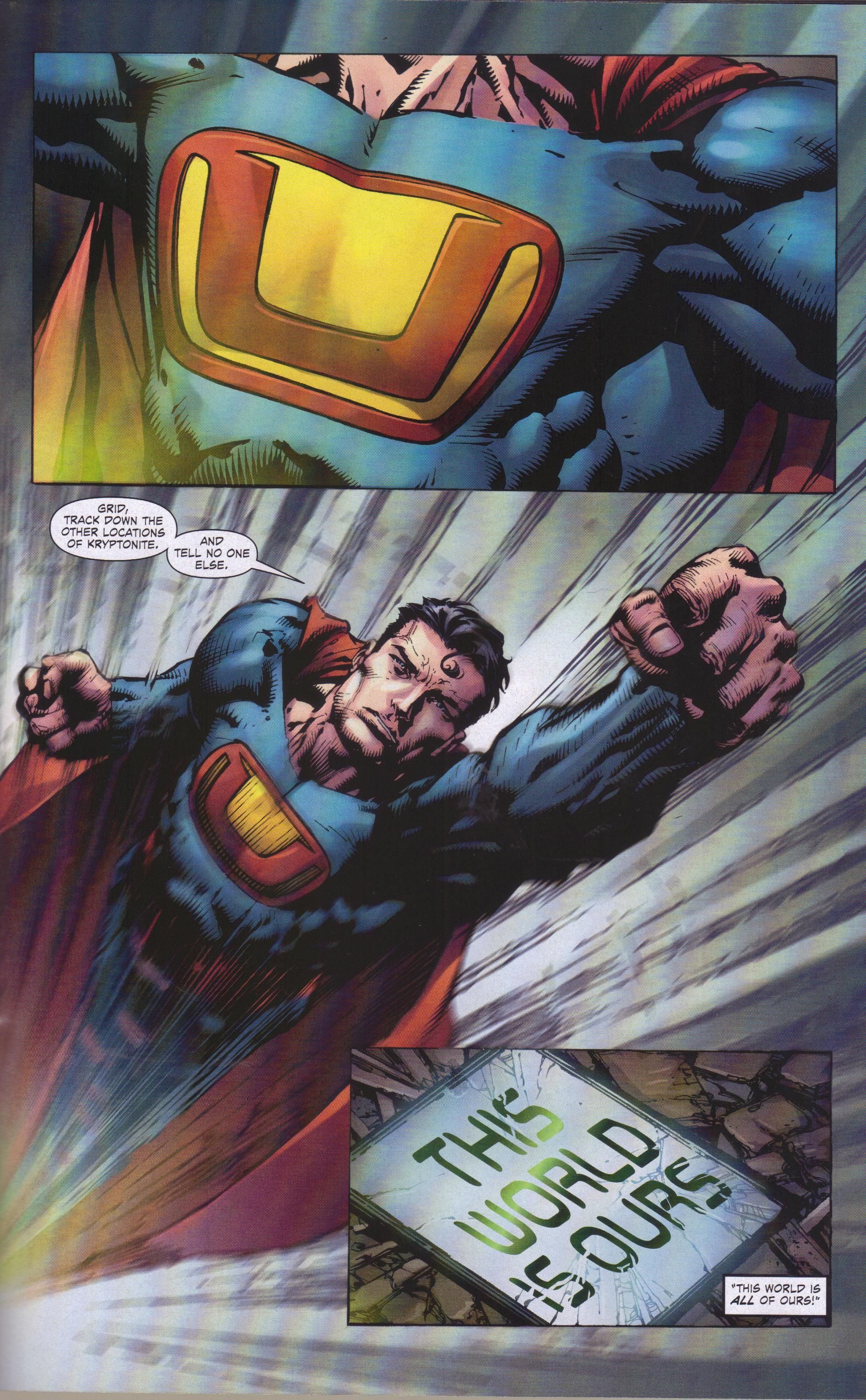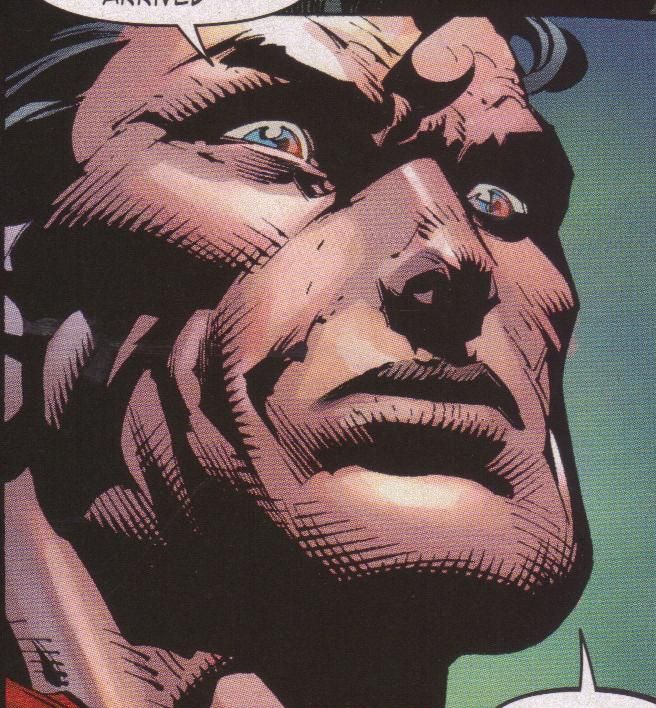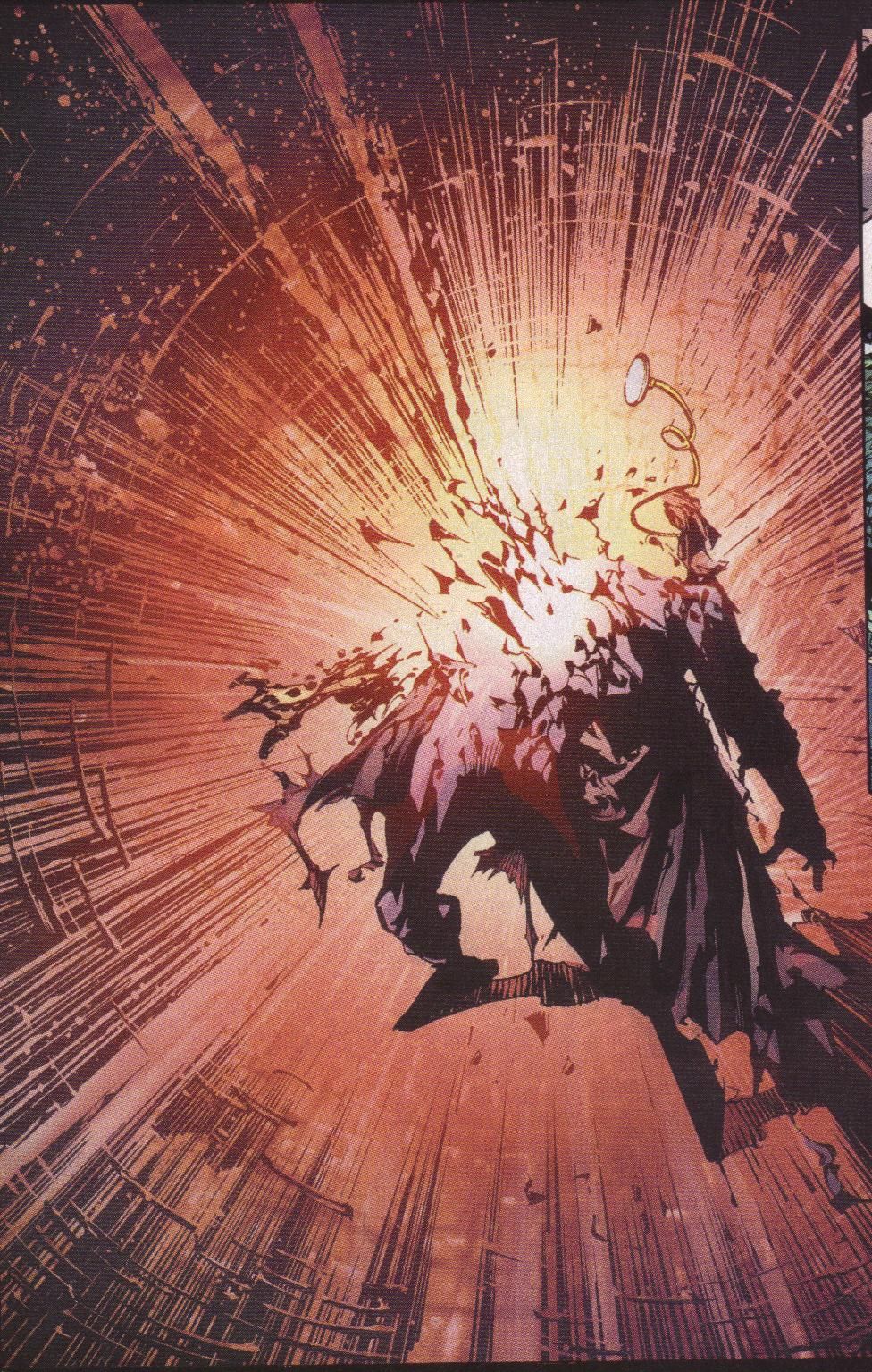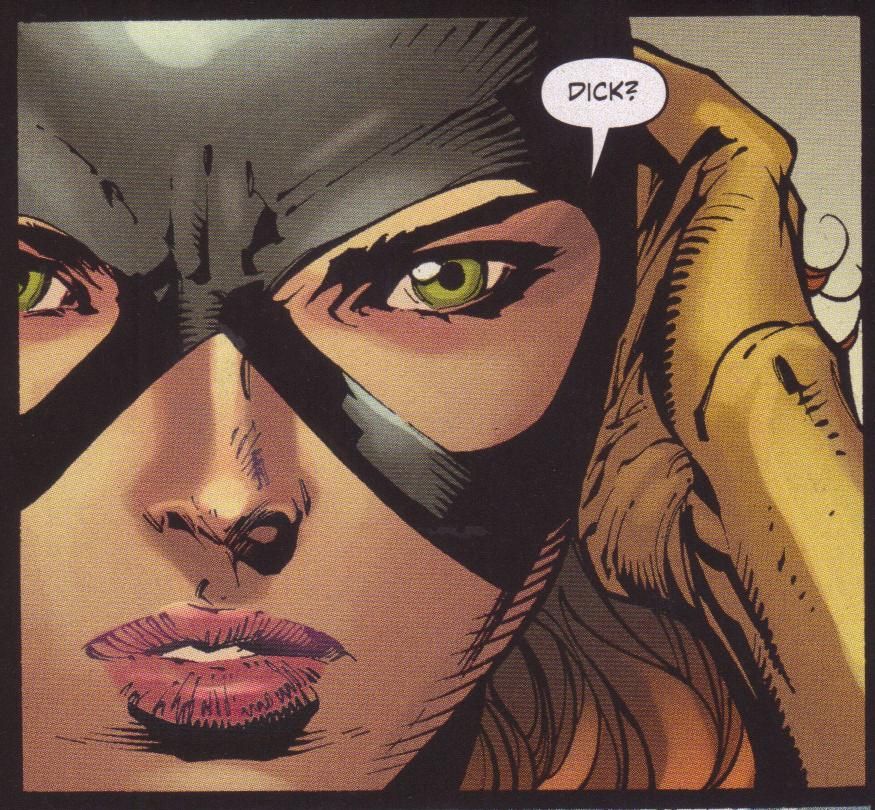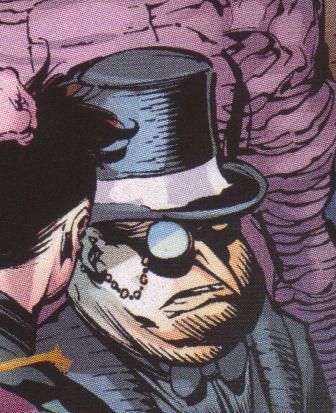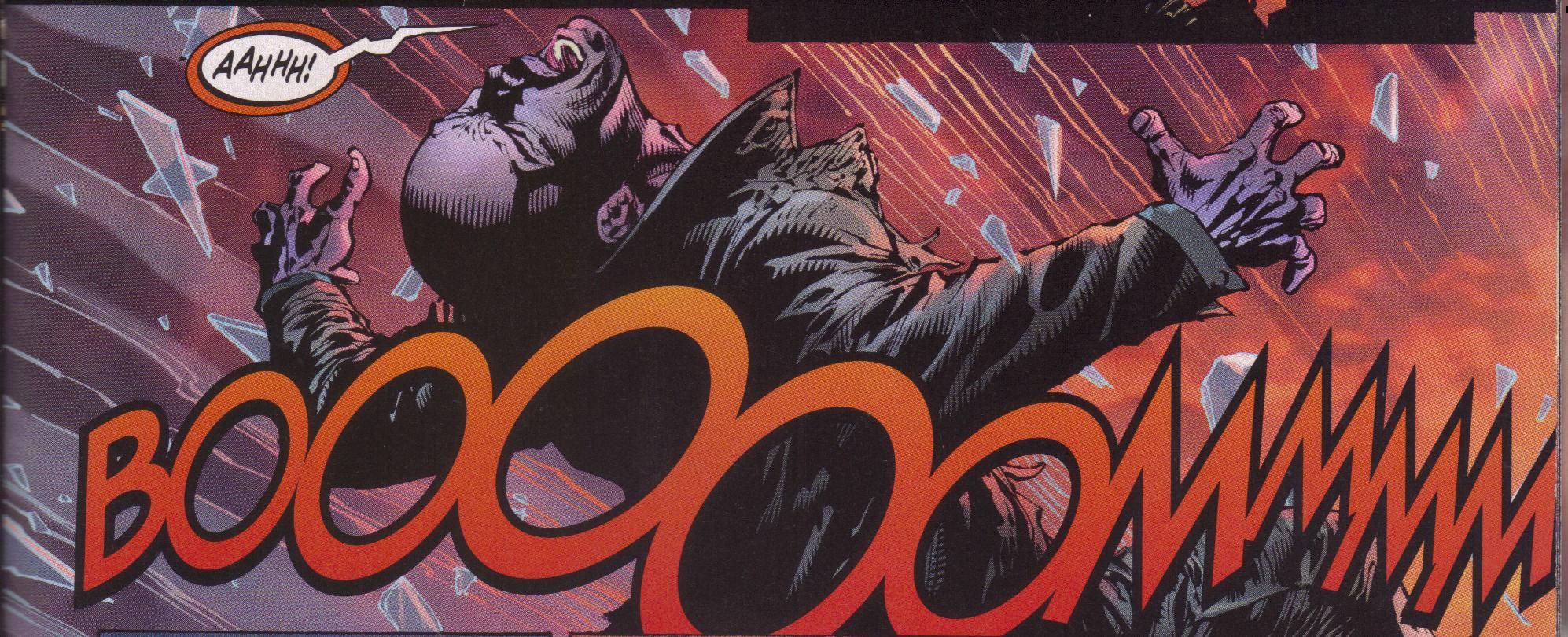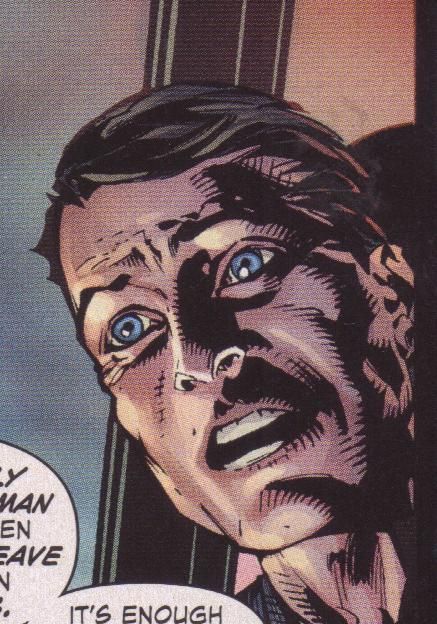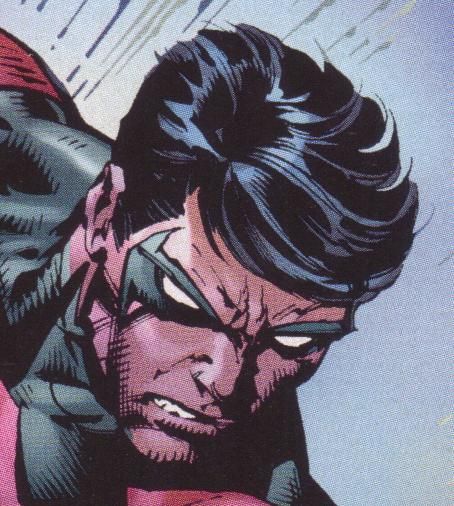Well, I did this with Infinity, so I figured I'd take a look at the big event from DC, Forever Evil. Yes, it's another minutiae-filled page-turning of a comic book! Oh, those are so much fun! And yes, I'm doing this in "real time." I haven't opened the book yet, so I'll write about things as I turn the pages! Whoo-hoooooooo!!!!!
First, let's check out the cover. I like the logo - it's red, which is the color of eeeeeevil, and the two "V"s look vaguely sexual, and we all know that sex = eeeeeevil. The angle on it helps draw us in, too - the entire cover is like a tunnel from which the villains and the logo are emerging. David Finch drew the cover, and I wonder if DC Editorial gave him a list of villains to put on the cover, because among all the long-timers, his own creation, the White Rabbit, shows up in the back, and now that Finch is no longer writing The Dark Knight, I very much doubt if we're ever going to see the White Rabbit again (I assume she shows up in this issue, because she's on the cover, but like so many heroes in the past, I will bet she's going to be relegated to "cannon fodder"). Lex Luthor is wearing his ridiculous armor, too, because one part of Geoff Johns still wants to believe it's 1977 and he's still playing with his Lex Luthor armored action figure. Jeebus, I hate that ugly fucking armor.
Anyway, onward! MASSIVE SPOILERS AHEAD!!! You've been warned!!!!
The credits are on the last page (I did flip through to see who did what, and realized pretty soon they'd be on the last page), so let's get it out of the way: David Finch (penciler), Richard Friend (inker), Geoff Johns (writer), Rob Leigh (letterer), Sonia Oback (colorist), Kate Stewart (assistant editor), and Brian Cunningham (senior editor) are the team that bring you this epic. The first issue is called "Nightfall." It's published, of course, by DC and costs $3.99.
Page 1: This is a three-panel stack, with each panel slightly different in height than the others. It's a standard "pull-out" shot from a giant pupil with a green-ish iris around it, to a complete eye (the right one), to a medium-shot of Lex Luthor wearing a trench coat. Nothing says "I'm 1990s cool!" like a trench coat. The caption boxes are colored green, and I wonder if green is Lex's default color - the eyes and the armor being the prime indicators. What's green? Jealousy. Lex is totes jealous of Supes, you know. Anyway, Lex is narrating about his sister's - Lena's (I don't know if this is long established, but come the fuck on, every Superman writer ever) - cat being stuck up in a tree and Lex rescuing it before chucking it into the river because it scratched him. The final caption box reads: "I was only trying to save it." If only all the stupid people in the world would stop worshiping Superman and let Lex save them, everything would be all right! Anyway, in the final panel, Lex asks "What's the story of my success?" as artist David Finch leads our eye to the right and toward the page turn. Behind Lex, there's some amorphous foggy color, like he's sitting in the middle of the northern lights.
Page 2: Ah, it's the twilight sky over Metropolis. That makes more sense. Lex is flying in a helicopter over the city, explaining that his success lies the skyline of Metropolis. He says that he's been cleared of all wrongdoing (there's no footnote explaining where we can read more about his wrongdoing and how he was cleared, but that's not surprising, and none of the asides in this comic get footnotes, either), he once again owns 90% of the city. The man he's speaking to, Thomas Kord, is sitting across from him in the helicopter. Lex is trying to buy Kord Industries, but Thomas won't sell to him, even though Lex is offering him twice what it's worth. He won't answer when Thomas asks him why Kord Industries is so important to him, instead going off on a tangent about the phrase "the survival of the fittest" before implying that he's going to throw Thomas Kord out of the helicopter. That's awfully mean of him.
Finch's layouts make the page perfectly legible, even if his actual line work is never going to be the best at showing actual human beings. He's much better with masked people, so Lex looks oddly drugged-out in both his close-ups, and Thomas Kord looks decrepit in all but one of his panels. Friend's inks are rarely anyone's friend, and Finch definitely doesn't need the heavy blacks highlighting his penchant for high cheekbones, as it makes both men look far too ghoulish. The quicker everyone can get into costume, the better for Finch.
Page 3: At the bottom of Page 2, Finch shows Kord leading us again from left to right as he asks Lex if Lex is threatening him. So at the top of Page 3, Lex can say, "No. No, Thomas. Please, don't misunderstand me. I'm not threatening you. I'm threatening your entire family." He goes on to explain how he will destroy Kord Industries, get his son into drugs and thrown out of Northwestern, hook his wife up with a dude who will then break her heart on the day the son overdoses and dies, which will then drive her to suicide. As he holds the papers out for Thomas to sign, there's a small panel of what looks like the instruments on the pilot's dashboard shorting out, and then the pilot yells out that they have a problem.
Once again, it's a fairly boring but effective layout - Finch really hasn't had much to do at this point in terms of bold storytelling. Both men still look like ghouls, and the light sources seem to be coming from Lex's left side, but his right side and Thomas's left side are a bit too bright for that. Either way, it's still a pretty boring book, visually, at least so far. There's a LOT of exposition.
I'm not sure what Lex's deal is in the DCnU. I mean, I know he's a bad guy in the early issues of Action Comics, but those are the only ones I've read, so I'm not sure what he's talking about here with regard to being cleared of any wrongdoing. I'm just flabbergasted that anyone gets in a helicopter with him, because he's a fucking villain and I'm sure there are rumors about him doing evil things to other business rivals. Nobody ever shows how Lex gets these people into the goddamned helicopters, they just end up there. The answer is, of course, that businessmen in the DCU (Original OR Extra-Gritty variant) are really, really stupid.
Page 4: A simple five-panel stack shows us that there's some kind of strange purple haze (all in my brain) zipping across the city that somehow knocks out all the ... lights? electronics? batteries? gas-powered vehicles? "The whole city's dark!" shouts the pilot in Panel 2, including the helicopter, which is plummeting toward certain doom. He can't reach anyone on the radio, and the helicopter speeds toward a helipad nose-first. Finch does a decent job - all the panels move our eyes from left to right, and he tilts things just enough to imply the vertigo Lex, Thomas, and the pilot are surely feeling. Oback uses some nice computer effects for the purple lightning - it's not too overwhelming, but it does the trick.
Page 5: In a big Panel 1, the helicopter smashes into the side of the building, which makes no sense as it was very close to crashing into the roof two panels earlier, but it's still a nice dramatic drawing. What's most impressive, actually, is the way Finch or Leigh letters the crash, as the "Boooom" sound effect arcs across the page, with the third "o" encircling the helicopter as it smashes into the building. It's a cool way to integrate the sound into the visual portion of the crash.
In the second panel, Finch draws the destroyed helicopter inside a nondescript room, with Lex lying on the floor in front of the wreckage. In the foreground, we see a shattered picture of Lex, which we get in close-up in Panel 3. It's a bit of a cliché, but what the heck - this ain't Shakespeare.
Page 6: Lex props himself up on his elbow just a bit in Panel 1, and it's just an establishing shot showing us that he's alive and that his phone is lying on the carpet in front of him. This is important.
Panels 2-4 show electronic device "ba-linking" to life. (I'm not sure about that sound effect: "ba-link." Is is accompanied by a little musical note? I don't own an iPhone, but my wife's makes a sound like a raspy lock opening. "Ba-link" sounds much smoother.) Anyway, the first panel shows Lex's phone doing it. The second panel shows his computer on the utterly destroyed helicopter doing it (his phone, which was in his jacket pocket, presumably, has a scratch on it even though it landed face-up on a carpet; the computer on the utterly destroyed helicopter is unscathed). The third panel shows another screen, but it's in extreme close-up so we don't see what's around it. Which screen is this? I don't know.
The third row of panels, at the bottom, gives us thinner Panels 5-8, repeating the screens coming to life, all now showing a message: "This world is ours." The final panel shows Lex staring into space, presumably still looking at the computer in the helicopter, which is where he was looking in Panel 3. Oback colors the screens orange and the letters green, which is not only a good color scheme but matches Lex's eyes. Well done, Ms. Oback! At the bottom of the last panel, a caption box of actual spoken dialogue (it's in quotation marks) reads "Metropolis is dark." DC really likes to put caption boxes in different colors or with different backgrounds to show different people speaking, and this one has circuitry behind the words, implying some kind of computer consciousness. Leigh's letters for that caption box and the threat/promise on the computer screens is kind of a retro-futuristic thing, kind of like what you'd see in the 1980s for how all lettering would look like in the far distant future of the year 2000 or something. Anyway, the page is very ... PORTENTOUS!!!!! (I couldn't resist!)
Page 7: We get a big panel showing a robotic-looking dude standing in front of a bank of computers and big monitor screens. The screens are all colored bright blue, and they appear to be blueprints, although one looks like it's just a negative-print view of a building. Anyway, the monitors show Arkham Asylum in Gotham, Belle Reve Prison in Louisiana, Blackgate Prison in Gotham, Badview (really?) Penitentiary in Philadelphia, Iron Heights Pen[itentiary] in somewhere (it's cut off by a giant black barrier in the foreground, which frames the scene), and Stryker's Island in Metropolis. I find it odd that the only real city on the monitor is Philadelphia. Is Johns saying something about Philadelphia and its population of malcontents? What does he have against Philadelphia?!?!?
Finch draws the scene slightly tilted from left to right, so that we naturally slide downward along the axis. It's not a bad trick. The robotic-looking dude is talking to someone on a electronic device who tells it "I'm already en route, Grid" - presumably to Metropolis. Grid answers that Gotham is the next to go "off-line," and that "we" will have worldwide power and communications control within the hour. Finch gives us a close-up of Arkham - presumably the next target - and then shows Grid's face - he's just an unpleasant-looking robot, as you might expect. He does tell the person on the other end of the line to have a nice day, so that's something.
Page 8: We get to see some superheroes, as Johns lets us know in the first dialogue balloon (which is again on the radio, as it features the universal symbol of radio-speak) that this is Nightwing. The person on the radio acknowledges that they tracked Nightwing, and that if they did, Batman did. Nightwing says he's only there to drop off Mr. Zsasz and then he's heading back to Chicago. In some awkward dialogue, Nightwing explains that Zsasz makes a slash in his skin for each victim, and no one knows why. As he drops Zsasz off at Arkham Asylum, he says he'll never understand the mind of lunatics, and the voice wonders if he's only talking about Zsasz. The voice on the radio is revealed to be a sexy red head, who wants get past the "Joker's lies" and "meet without the masks." She mentions Bruce and Batman, but it's unclear whether she wants to meet Nightwing alone or Nightwing and Bruce. It doesn't really matter, because as they're speaking, the same purple mist from Metropolis shows up and futzes with Nightwing's radio, and he hears "This world is ours" in his ear. Oh dear.
We get a lot of information on this page, and Johns is clearly tying it into the bigger DCnU, as Nightwing and Hot Red Head (I know it's Barbara Gordon, but Johns doesn't identify her, so why should I?) allude to something bad that happened with Batman and the Joker. So that's cool - it's vague enough and tangential enough that it doesn't feel too important, and like Lex's new freedom, it's not explained in a footnote or anything, but that's the way it is, I guess. Visually, this is a bad page. Sure, Finch's layouts open up just a bit and he gets us from Point A to Point B well enough, but it's both weird and ugly. In Panel 1, Nightwing is swinging over the city, holding a rope in his left hand. The rope is wrapped around his hand, and it's trailing behind him off-panel. That's not the problem. The problem is that his arm is almost straight, even almost hyper-extended, and it seems impossible that he could swing that way. You might almost miss it, though, because the rest of the drawing is so weird. Nightwing is carrying Zsasz on his right hip, sort of, with Zsasz a bit behind him. He's supporting Zsasz - whom Finch draws as a fairly bulky dude, so let's say he's maybe two bills, maybe 175 - with just his right hand wrapped around Zsasz's shoulders and Zsasz's right shoulder balanced on Nightwing's thigh. If you can explain to me how Nightwing is swinging over a city holding Zsasz in that manner, you're a better person than I am.
In Panel 2, Finch and Johns use the old "Have a character begin a thought in one location and then, between panels, have said character completely change location but continue the same thought" trope. Nightwing says at the end of Panel 1 that he doesn't know why Zsasz does what he does. In Panel 2, he's crouched in front of Arkham Asylum and says, "I'll never understand how the mind of a lunatic works." Arkham Asylum presumably is not in downtown Gotham City, so somehow Nightwing covered a great distance between breaths. I know this is a standard cliché in comics and even television/movies, but it's still dumb. Meanwhile, Finch draws Hot Red Head as a horrible 1990s Image chick, as she's working with tools on some kind of machine yet still has the presence of mind to arch her back seductively. Plus, her waist is tiny and her thighs are weirdly huge. What's up with that? Finally, Finch is still working with human faces instead of masks, even though Nightwing wears a domino mask. So his face is ... well, not good.
Page 9: After the weird purple mist comes through, Nightwing looks up to see something "fwooshing" toward Arkham. He says, "Batgirl?" and then, after he climbs over the wall, he asks if she's still there. So Hot Red Head is Batgirl. Good to know. (Oh, if we consider all that has happened so far with Nightwing, he's transporting a serial killer back from Chicago by swinging through the city while carrying him, and then it appears his plan is to simply dump Zsasz at the gates of the insane asylum. Even though Zsasz apparently killed more people while in Chicago, which seems to imply Nightwing should have turned him over to the Chicago justice system, at least. Maybe they have a better prison system than Gotham's notorious "Let's keep everyone in costume and hire only guards who happen to be related to the inmates!" policy.) Anyway, Finch's layout of this page isn't the greatest. Panel 2 is directly on top of Panels 4 and 5 veering toward the right side of the page, while Panel 3 is on the left side of the page but extending farther down the page than even Panel 5. There's nothing that indicates we're supposed to go from Panel 2 - Nightwing on the inside wall of the asylum and looking to the right - to Panel 3. If anything, the way the page is laid out makes it seem we're supposed to go straight down to Panel 4. Panel 3 shows a woman standing in front of the giant doors of Arkham, and it's somewhat clear (not completely, but clear enough) that she was the "fwoosing" flash of light in Panel 1. She says "Arkham Asylum? It is a prison." The usual villains' trope of not using contractions makes this statement a bit more confusing than it should be - the woman questions that they call it an asylum, because it's clearly a prison, but the emphasis on "is" in the second sentence sounds weird if it's said aloud, and less weird if she would have said "It's" an emphasized that. In Panel 3, the woman grabs the steel doors and crunches them between her fingers, and in Panel 4 she tosses them aside like they're lettuce leaves. The sound effect when she crunches the steel is "rank." I guess. In Panel 6, Nightwing leaps into action, his face twisted in an angry grimace, and he tells Batgirl that if she can hear him, there's major trouble at Arkham and she should have Batman contact the "league." As Finch leads us to the page turn, Nightwing says "I'm going to see what I can --"
Page 10: Nightwing doesn't get to finish his sentence, because in Panel 1, he's slugged by something. His head snaps back, blood (quite a lot of it) sprays from his lips, and there's a sound effect of "Krraak" on his left side, along with some speed lines. In Panel 2, he's hunched over with blood and spit sputtering from his face, and a word balloon says "Behind you." This is pretty effective - we're seeing him from the back, so in good horror-movie fashion, he'll need to turn around and face the reader to see what's going on. However, in Panel 3, he isn't seen - he says "Batman?" off-panel, and we see a shadowy figure with glowing eyes off to the right. In Panel 4, the figure punches him again in the chin, but from the front. So who's behind him, and did Nightwing turn around? He gets pummeled for a few panels, and then a golden lasso encircles his neck as two word balloons explain that he's called "Nightwing" and that "he will do." He's yanked upward and off the page to the right. At the bottom of the page is a word balloon with "Help!" inside it. It's obviously a box that helps transition into another scene, which is what comics do quite often.
Page 11: We're back with Lex, who's rubbing his eyes to clear his head. Thomas Kord is hanging off the tail of the helicopter, and he's begging Lex for help because he can't hang on. Lex cleverly looks at the contract he wants Thomas to sign before beginning to move toward him. This is very weird, because when the helicopter crashed, it was very clear that Thomas Kord was not hanging from the tail, so are we supposed to believe that he crawled out to the tail of the helicopter? The helicopter hasn't tilted or anything, so how did Kord get out there? Anyway, before Lex can do anything, he hears two sonic booms and sees someone who looks like Superman speeding toward him. In the first panel (Panel 8 of the page, but the first two rows and seven panels are about Kord hanging from the helicopter), it appears that Superman smashes through part of a building, and then in Panel 9, he streaks directly toward Lex. Lex can only say "Super --?" before the page ends. Lot of people getting cut off in this comic!
Page 12: We knew Lex was going to get smashed by "Superman," and so he does. In Panel 1, a red blur flashes past him, and somehow knocks him forward. The blur doesn't seem to come anywhere near Thomas Kord, but he was right on Page 11, as he can't hang on anymore, and we see him fall. In Panel 2, Finch gives us a closer-in shot of Kord falling, and in Panel 3, "Superman" ignores his call for help, proving that it's either not Superman at all or it's Zack Snyder's Superman. Much like the woman at Arkham, "Superman" grabs some steel doors and rips them open, throwing them behind him and out the giant hole in the building. The sound effect for these doors getting ripped apart is "Spltt". "Superman" stalks through a corridor, demanding to know where the hell "it" is, and Lex once again wonders if it's Superman. "Superman" finds what he's looking for, and punches through the wall and extracts a glowing green piece of crystal. Underneath his hand, another transitional caption box has the dialogue "Don't touch it!" inside it, which of course is being said in a different scene but refers to Superman not touching Kryptonite.
Finch is really packing in the panels - 9 each on Pages 11 and 12 - but while his line work isn't the best, there's nothing wrong with his storytelling, even with the cramped panels. Finch certainly knows how to move our eyes over the page, and it's just unfortunate that so far, his penciling hasn't been all that great. But let's move on!
Page 13: A caption box explains that we're in Central City at Iron Heights Penitentiary. This is the first time Johns has felt it necessary to give the reader a tag explaining where the action occurs, and it's probably for two reasons: For Metropolis and Gotham, he was able to reveal where the characters were through their dialogue, and Metropolis and Gotham are far more famous than Central City. So we know where we are, and we know that a character has said "Don't touch it!" just before we reached this page. The characters are standing in front of a fence, and the same person who spoke on the previous page says, "It's electrified." That voice comes from off-panel, and the character in the panel is Captain Cold, although he's only called "Cold" on this page. He tries to freeze the fence, but he produces too much ice/snow (it's not clear) and whatever he was trying to do doesn't work. His ineptitude is there just so the other bad guys can show off - "Heatwave" tells him he can melt through the fence, so he does. Meanwhile, we learn that these bad guys have powers, but they're not used to them. "Weather Wizard" says he was happy "waving a wand," but now he talks to thunder gods. We also learn that they're breaking into the prison to rescue "Trickster," because, as Cold puts it, "the rogues take care of one another." The last member of their little group is Mirror Master, by the way. Finch is back to not having much to do, except draw Weather Wizard with long, flowing, 1990s hair. Good stuff!
Page 14: Something explodes (the fence?) blasting all the "rogues" backward, and a word balloon edged in red announces that it's "cray-cray time!!!" Ugh. Oh well. In Panel 2, a red blur with lightning crackling through it moves through the fence and smashes the wall of the prison, and whoever does it laughs as he does so. The rogues wonder if it's the Flash, and we see a silhouette standing inside the prison, which what looks like a small figure standing on its shoulder. The small figure calls the big one "Johnny" and says they're going to have so much fun together. A guard pulls his gun and tells the thing not to move, and then we get a confusing panel. A word balloon reads "Don't move? That's all I do!" and it appears that the speedster somehow turns the guard into a skeleton. Is that right? The gun is floating above the skeleton's hand, so I'm going to assume it's the guard, somehow with all the flesh stripped from his bones. The final panel shows a close-up of Captain Cold, announcing that it's not the Flash.
Page 15: We're at Belle Reve Prison in Louisiana, and over an establishing shot, we get two dialogue boxes in which someone helpfully defines "psychopath" for us. The person concludes by telling the subject that he's a psychopath, plus he's a "whiz with a fishing knife." In Panel 2, we see a dossier with the subject's "supervillain" persona - some dude in the water wearing a weird bug-shaped mask. In Panel 3, we learn that he calls himself "Manta," but that costume looks like an insect. Anyway, we're in a cell, and Manta is sitting on his bed while a foxy woman stands near him, telling him that he's a perfect candidate for "Task Force X." Manta calls it "the Suicide Squad" and names the woman - Waller - before expositing that if you do a mission for the squad, you don't go free, you just go on another mission. Waller asks Manta what he wants, and he says the only thing he wants is the death of Aquaman. Before anyone can follow up on this, there's an explosion outside the cell and green smoke puffs up against the bars. In Panel 6, we get a shot of two flying silhouettes entering a big hole in the ceiling. One of the silhouettes has flames where his hair should be. He says that they don't have time to waste, because they still have a lot of prisons to open up. The other silhouette says, "I just want to get this over with and get b-back." Stuttering is the universal symbol for being scared, and the first silhouette tells him there's nothing to be afraid of.
A reader picking this book up with not a lot of knowledge about DC comics might think nothing of this page, but did everyone notice that Waller is pretty much white? I mean, they sexed her up in the DCnU, because if you're out of shape you can't appear in a DC comic unless you're the subject of cruel humor, but she was still, you know, black. I don't know what Oback is doing with this page - there's really no question that Waller is white in these panels. Shouldn't someone have noticed? Manta is black, too - maybe DC had reached their quota for minorities appearing on one page, so if Waller was black too this page would have been way too politically correct? It's really weird. It doesn't help that Waller looks dangerously emaciated in the panel where she looks out at the explosion. That's just creepy.
Page 16: "This is our world now" begins the page, and I suppose it's Flame-Head continuing his thought from the previous page. We're back in Metropolis, and Lex is watching "Superman" as he crushes the Kryptonite, heats it with his vision, and snorts it. "Superman" laughs and says "I'm the strongest again." We still haven't seen his entire face, which is interesting, as it's not like Johns is trying to pretend it's the real Superman. Oh well - Lex is staring at "Superman," and he sees ...
Page 17: Panel 1 shows us the "U" on "Superman's" chest, finally clearing up that it's not the real Superman. In Panel 2, we finally see Ultraman's face as he flies away ... somewhere (speed lines surround him, so we have no idea where he's going). He's speaking to Grid, telling him to locate all other Kryptonite and don't tell anyone he's doing it. In Panel 3, we get a small inset of the screen still reading "This world is ours" and a dialogue box where someone says, "This world is all of ours!"
This is a weird page simply because of the way Finch has set up the previous pages. We have to re-orient ourselves on a different axis, because we've seen Superman standing in the foreground while Lex crouches in the background. Even when we see Ultraman's chest in Panel 1, we're seeing it from Lex's point of view, so if we can imagine it, Lex would be in the foreground, looking back toward Ultraman. However, in Panel 2, Ultraman is obviously no longer in the building, and he's flying from the lower left to the upper right. If we keep our old orientation and look at this from Lex's point of view, it makes no sense. Comics, of course, take great advantage of the space in the gutters to move characters around, but this is a tough switch, or at least it seems so to me. I could be wrong. Especially as the screen in Panel 3 seems to imply we're still in the wrecked building with Lex, so we have to jump from that building to Ultraman flying somewhere, and then quickly jump back to the building to check in on the screen, which is only necessary so that Johns can have the final dialogue box that enhances the original message. Is it really that important?
Page 18: We pick up with the speaker on the bottom of Page 17, and we get a panel of two hands holding two coins. The first voice says that it's "their" time, and she addresses the Riddler. But "Freeze" answers, skeptically. The Scarecrow says they're communication devices - the only ones that work now. Everyone has been invited to join the "Secret Society" - dang, that's a generic name. The Riddler points out that the continents depicted on the coin are backward, and Poison Ivy says that they shouldn't join because the Justice League will stop the bad guys. Scarecrow is in the bag with the rescuers, and Two-Face wonders if they can be trusted, which is pretty hilarious, if you ask me. Two-Face, of course, flips the coin he's been giving, which leads to ...
Page 19: It's a full-page drawing of "the remains of the Justice League watchtower" in Happy Harbor, Rhode Island. In the middle of the page, we see a bunch of people going inside the ruin. In the upper left, a dialogue box from Two-Face reads "I'm in." Of course he is!
Pages 20-23: Then we open up these two pages to find a four-page spread. Two-Face redundantly says "We're all in" in the upper left corner, and Finch draws every villain he and Johns could think of. In the middle of the spread, the shadowy figures who have been opening the prisons stand with their backs to the reader, and they're still shrouded in shadow. But we get a bunch of villains standing around, staring up at them. I guess it's supposed to be impressive? It's pretty boring, unfortunately. I mean, it's just a bunch of villains standing around. Did we really need four pages for it? It's certainly nowhere near as neat as Steranko's famous four-page spread (thanks to Bully for that scan). Oh well. A lot of villains show up. Including Mr. Zsasz, whom we last saw gagged and bound. Did that lady bad guy stop in her mission and free him? I guess she did. I also like that the Mad Hatter stopped to make a cup of tea. He's refined! Oddly enough, I don't see the White Rabbit, even though I guessed from her presence on the cover that she would be in the issue. This is the only place she would be, and Finch doesn't draw her. Interesting.
Advertisement Page 1: It's a house ad for a Captain Marvel collection by Geoff Johns and Gary Frank. Remember when Captain Marvel was a fun hero? Yeah, none of that shit in the DCnU! It is pretty impressive that DC didn't put an advert in until this point in the comic. Well done, DC!
Page 24: This page exists basically to introduce several villains. We find out that Despero is claiming that he destroyed the Justice League HQ (wait, the Crime Syndicate didn't do that?), although Poison Ivy claims someone must have "torn it right out of the sky," which makes it sound like a satellite. Is it a satellite? "Watchtower" and "satellite" are very different things. Ultimately, though, this is just a page for villains to name each other and talk about what they're going to do. Will they listen to the newcomers? Will they walk? Will Deathstroke kill someone? It's not that interesting a page.
Page 25: From the upper left, a trident "clangs" down among the assembled bad guys. Several people reach for it, but Manta claims it. So it goes with Wonder Woman's lasso, which Cheetah grabs, and Superman's cape, which two villains - Metallo and some ugly pink dude (Parasite?) - struggle over. In the final panel, a voice from the right says, "There will be no discord among us. This world is ours."
Advertisement Page 2: A house ad for the latest iteration of Batman: Black and White. I like the whole idea of Batman: Black and White, so I'll probably get this in trade. If DC were smart (hey, it could happen!), they'd include this.
Page 26: Another full-page spread, revealing the bad guys - villainous versions of the Justice League. Ultraman announces that the Justice League is dead, and crazy Flash says, "Hell, yes, they are." There's not much for Finch to do - they're all just posing. Faux-Firestorm is a member of the Bad Guy Justice League, which is a bit weird. But the rest are standard - Bad Guy Green Lantern, Bad Guy Batman, Bad Guy Wonder Woman, and Bad Guy Flash. The small person on the Flash's shoulder is a girl - Bad Guy Atom, I guess.
Page 27: Grid explains that Ultraman is live across the world, so Ultraman introduces Owlman, Superwoman, Power Ring, Deathstorm, Johnny Quick, and Atomika. Power Ring doesn't like how the villains are looking at them, Deathstorm tells him to be calm, and Atomika loves the attention. Ultrman explains that they're the Crime Syndicate, and they ruled their world until it turned against them, so they destroyed it and went looking for another one, and they chose this one. He claims that they've killed the Justice League. While he's talking, we see Lex Luthor watching on a monitor in the destroyed building, so he's up to date. Before Ultraman can finish, a villain called "Monocle" (because he wears a monocle, don't you know) claims that it's a big trick, because the Crime Syndicate is actually the Justice League - I mean, look at them! I don't know - Finch draws Ultraman as awfully maniacal, and you think Monocle would see that. Plus, the villains were already in custody. Why would the Justice League trick them into getting together just to capture them again? I guess that's what you get from a dude who names himself after his eyewear. Finch draws Ultraman with a really big chin, too.
Page 28: Well, you knew that would happen: Monocle explodes (although his monocle survives - yay!) in Panel 1, and I guess we should be happy it took Johns 28 pages to get to someone exploding. The villains consider the stain on the floor in Panel 2 and one of them says, "Dude, they ain't the Justice League." Ultraman tells them that if they pledge allegiance to the Crime Syndicate, they'll be in charge, but if they question things, they'll be dead. Watching on a monitor are a few heroes - the only one who is identified is Robin, sitting in the foreground. Some chick asks him if he thinks the Justice League is really dead, and he doesn't have an answer for her. Back with the villains, Ultraman tells Superwoman to "haul him up."
Page 29: This is not a terribly decompressed comic - lots of stuff has happened so far - but Finch takes four panels for Superwoman to drag Nightwing onto the stage. Man, that's too many. The page is laid out so that she can reveal Nightwing in the middle row, and it's all dramatic and shit (poor Nightwing is still bleeding from his mouth, or maybe her rough treatment has re-opened a wound), but it's still a waste of space. Anyway, she shows Nightwing to the crowd and begins to take his domino mask off. What will happen?!?!?!?
Page 30: Dang, she pulls the mask clean off and reveals that his real name is Richard Grayson. Blood is still flying from his nose, even though she hasn't moved his head. That's some crazy blood! In Panel 2, Robin says, "Oh, my God" and in Panel 3, someone (Batgirl, probably) is shown in close-up with her mask on. She says, "Dick?" Does this mean she didn't know Nightwing's secret identity? That can't be it, because it's pretty clear earlier in the issue that she does, so why the puzzled statement? Where is she, anyway? The panel is so close in that we get no context for where she is. She's not with the other heroes, that seems clear. In Panel 5, Lex wonders who Dick Grayson is, and the screen he's watching "ba-links" to Dick's Illinois driver's license and a story about the death of his parents in the Gotham Gazette. That's certainly helpful!
Page 31: Power Ring wonders why Owlman didn't protect Dick, and Deathstorm points out that Dick is a weaker copy of Owlman's former partner. The Crime Syndicate - mostly Ultraman - explains that they know everyone about Dick Grayson and will hunt down and destroy everyone and everything he cares about. If anyone opposes them, they will kill everyone those people love. Ultraman explains that this world protects the weak, which holds back the progression of the human race. He says the destitute are winning, but the war is not over. Finch draws a really ugly Penguin, man.
Page 32: We get three panels of the villains spreading chaos all over the world while Ultraman continues his grandiloquent narration. Then we're back at the JL HQ, and Ultraman concludes by saying "Aeternus Malum" - "Forever Evil" - to, well, nobody. Everyone is gone. I wonder if the rest of the Crime Syndicate is thinking that maybe he should shut up. Then we see Ultraman's weakness - the sun rises and causes him some pain, so he flies away. While he's doing that, there's a caption box that reads "It's funny." The caption box is green, so it probably belongs to Lex Luthor.
Page 33: Ah, yes - Lex is still thinking about the cat. He wonders if he should have jumped into the river after it, even though he threw it in there in the first place. As he does this, he watches the sky through the hole in his building. Ultraman, it appears, is moving the moon so that it blocks out the sun. This is a confusing page, honestly. I mean, it's clear that Ultraman is moving the moon (let's not think about what a phenomenally stupid idea that is), but in Panel 3, Lex is suddenly thrown backward by a sonic boom and what looks like shards of glass flying right at him. In Panel 4, he shows no sign of being cut by glass, just like in every movie ever where people can jump through giant windows and have no wounds whatsover. Yet there's a lot of blood on the ground behind him. Is that his blood, or the pilot's? It's probably not Thomas Kord's, as he seemed unharmed before he, you know, fell to his death. In the final panel, Lex says aloud, "This is a job for Superman," so are we supposed to think that Superman flew past in Panel 3? It's very weird. Perhaps Page 34 will shed some light (so to speak) on the subject!
Advertisement Page 3: A house ad for DC supervillain action figures. Black Manta is pretty neat, I guess.
Page 34: Well, nope. This is the last page of the comic, and Lex kneels awkwardly in front of the now-eclipsed sun, which appears to be about five feet away from him. Seriously, what the hell? Lex says, "So where the hell is he?" and then we get the DUM-DUM-DUMMMMMM! music and the credits. Okay!
The next two pages show every single one of the villain-centric DC comics being released in September. I have to admit, those 3-D covers are pretty keen, although I'm pretty sure they're not worth the extra dollar. I mean, I bought one - the Joker one - and it was kind of dumb. Nice art, though. The last page is the explanation of the process by which the covers are created - DC has been running this in their issues for about a month, so you've probably seen it. Thus endeth the issue!
**********
This is a set-up issue, obviously, and while it's a bit more focused than Infinity #1, it's about the same in terms of story. We get a lot of disparate scenes that coalesce into a major threat, and the heroes haven't done squat yet. After reading about the Trinity War, I thought this would be much harder to follow, but it wasn't at all, and I'm not sure how seamlessly it flows from the end of that brief event. Doesn't that end with the Crime Syndicate showing up? So between the end of that issue and the beginning of this one, the Bad Guy Heroes have utterly defeated the Justice League? Man, that's a weird gap.
Anyway, Geoff Johns is the only writer allowed to do these events anymore at DC, so unlike Marvel, which has a few writers they can use and so there's a slightly different vibe between a Hickman-written event and a Fraction-written event, this "sounds" the same as Flashpoint, the last Geoff Johns-written DC event I read. None of the characters really exhibit any personality, as they exist simply to move the plot along. Johns relies on stereotypes, but that's to be expected. The mildly interesting bit is that Lex seems to be more interested in saving the world than throwing in his lot with the Crime Syndicate, but that seems kind of par for the course for Lex - he's definitely a "better to reign in hell than serve in heaven" kind of dude. This is marginally more exciting than Infinity, but it's not necessarily a better comic.
Unfortunately, David Finch isn't really the best artist for this kind of thing. Jim Cheung might have gotten a pass for Infinity because despite the fact that all his faces look alike, he's a much better pure superhero artist than Finch is. Finch's characters all look very similar - even more so than Cheung's, in fact - so it's hard for him to do good character work, but his pencils aren't really suited for superheroics, either. I maintain that his best work was on Moon Knight, because his obsession with detail and violence worked really well on a street-level book, especially when the whole point of that book was that Moon Knight was too violent. He's too big a star to not work on superheroes, though, but his designs are too busy and gritty to make them truly superheroic. His storytelling has never been bad, and for the most part on this book, he gets us nicely across the page, but he's called upon to draw far too many unmasked people, and he's not very good at it. As I mentioned, Richard Friend is not helping him, as his hatching just makes everyone look constipated and emaciated, which is a weird combination. The last time I saw Friend's inking, he was bludgeoning poor Amy Reeder's work in Batwoman, and I might have to go back and see if he's done this to other artists and is just not a good inker or if DC keeps putting him with the wrong artists. As if to prove my point about Finch, the best-looking characters in this book are Two-Face, the Scarecrow, and Deathstorm, characters who either have inhuman faces or are wearing creepy masks. I have a feeling Finch would be very good on a gory horror book, but of course, those don't sell a lick.
Anyway, I tried it. Forever Evil isn't all that good, but it's an event book, and I don't really think people read event books because they're good, they read them because crazy shit happens. Like Infinity, it's a good value - 34 pages for 4 dollars, and only three advertisements interrupting the action. I mentioned that the comic isn't all that decompressed, but I meant that in terms of not taking a lot of time to show shit happening, because if you consider what really happens in the book, Johns does take his sweet time. I mean, the first 3 pages show Lex making typical Lex threats to a character who falls to his death not long after this. We see the weird purple lightning thing twice, which is one more time than necessary. The four-page spread of villains is completely unnecessary. Johns could probably have fit the entire plot in about half the pages. But that's the way it is in modern comics, and we have to deal with it.
Like so many Big Two events, there's a sense of staleness around this comic, because it's nothing we haven't seen before. Is Johns going to try anything interesting at all? So far, it seems the answer is "no," but we can live in hope. I wasn't planning on buying the rest of this series, but if it had been really great, I might have considered it. This is yet another retread, though, so I'll definitely skip the rest. It's mildly entertaining, but that's about it.
Rating: ★ ★ ★ ★ ★ ½ ☆ ☆ ☆ ☆

